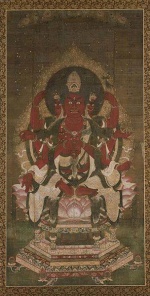Difference between revisions of "Hayagriva (Buddhism)"
| Line 1: | Line 1: | ||
| − | In Tibetan and Japanese Buddhism, Hayagriva is a wrathful manifestation of [[Avalokiteshvara]]. There are believed to be 108 forms of Hayagriva. His special ability is to cure diseases, especially skin diseases even as serious as leprosy, which is said to be caused by the | + | In [[Tibetan Buddhism]] and [[Japanese Buddhism]], Hayagriva is a wrathful manifestation of [[Avalokiteshvara]]. There are believed to be 108 forms of Hayagriva. His special ability is to cure diseases, especially skin diseases even as serious as leprosy, which is said to be caused by the [[Nāga]]s (water spirits with serpent bodies). |
| − | [[File:Bato Kannon painting.jpg|thumb|150px|]] | + | [[File:Bato Kannon painting.jpg|thumb|150px|Hayagriva, known as Bato Kannon in Japan]] |
| − | In Hinduism, one tradition identifies Hayagriva as a group of demons subdued by Vishnu, according to another tradition, Hayagriva was incarnation of Vishnu. | + | In Hinduism, one tradition identifies Hayagriva as a group of demons subdued by [[Vishnu]], according to another tradition, Hayagriva was incarnation of Vishnu. |
| − | In Tibet, Hayagriva was promoted especially by Buddhist teacher Atisha. It is said that Tibetan horse-dealers worshipped Hayagriva because he could frighten away demons by neighing like a horse. When invoked he announces his coming by neighing, the sound of which pierces false appearances and disguise. | + | In [[Tibet]], Hayagriva was promoted especially by Buddhist teacher [[Atisha]]. It is said that Tibetan horse-dealers worshipped Hayagriva because he could frighten away demons by neighing like a horse. When invoked he announces his coming by neighing, the sound of which pierces false appearances and disguise. |
==Buddhist iconography== | ==Buddhist iconography== | ||
| − | Hayagriva statue in Samye Ling. Note the green horse's head on top of his head. | + | [[File:Hayagriva_Samye_Ling_July_09.jpg|thumb|150px|Hayagriva statue in [[Samye Ling]]. Note the green horse's head on top of his head.]] |
| − | + | In his simplest form Hayagriva is depicted with one face, two arms and two legs. Everything about him is wrathful - a scowling face with three glaring eyes, a roaring mouth with protruding fangs, a pose of warrior’s aggressiveness, a broad belly bulging with inner energy, a sword raised threateningly in his right hand (poised to cut through [[delusion]]), his left hand raised in a threatening gesture and snake ornaments. This terrifying aspect expresses compassion’s fierce determination to help us overcome inner egotism and outer obstructions. | |
| − | In his simplest form Hayagriva is depicted with one face, two arms and two legs. Everything about him is wrathful - a scowling face with three glaring eyes, a roaring mouth with protruding fangs, a pose of warrior’s aggressiveness, a broad belly bulging with inner energy, a sword raised threateningly in his right hand (poised to cut through delusion), his left hand raised in a threatening gesture and snake ornaments. This terrifying aspect expresses compassion’s fierce determination to help us overcome inner egotism and outer obstructions. | ||
{{W}} | {{W}} | ||
[[Category:Hayagriva]] | [[Category:Hayagriva]] | ||
Revision as of 15:44, 30 June 2013
In Tibetan Buddhism and Japanese Buddhism, Hayagriva is a wrathful manifestation of Avalokiteshvara. There are believed to be 108 forms of Hayagriva. His special ability is to cure diseases, especially skin diseases even as serious as leprosy, which is said to be caused by the Nāgas (water spirits with serpent bodies).
In Hinduism, one tradition identifies Hayagriva as a group of demons subdued by Vishnu, according to another tradition, Hayagriva was incarnation of Vishnu.
In Tibet, Hayagriva was promoted especially by Buddhist teacher Atisha. It is said that Tibetan horse-dealers worshipped Hayagriva because he could frighten away demons by neighing like a horse. When invoked he announces his coming by neighing, the sound of which pierces false appearances and disguise.
Buddhist iconography

In his simplest form Hayagriva is depicted with one face, two arms and two legs. Everything about him is wrathful - a scowling face with three glaring eyes, a roaring mouth with protruding fangs, a pose of warrior’s aggressiveness, a broad belly bulging with inner energy, a sword raised threateningly in his right hand (poised to cut through delusion), his left hand raised in a threatening gesture and snake ornaments. This terrifying aspect expresses compassion’s fierce determination to help us overcome inner egotism and outer obstructions.
